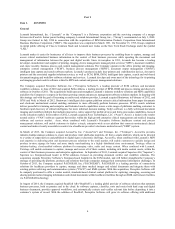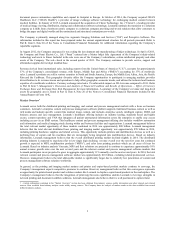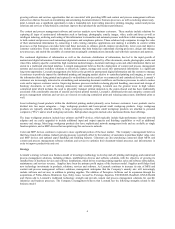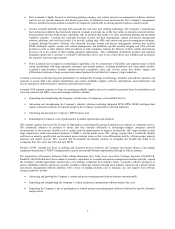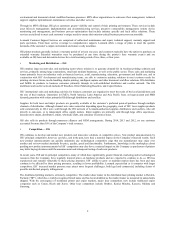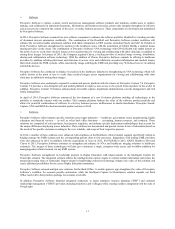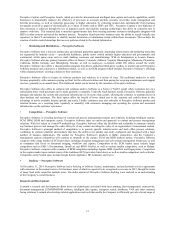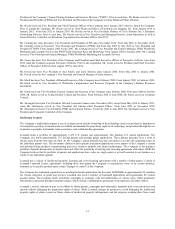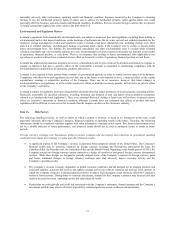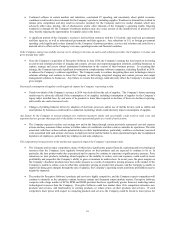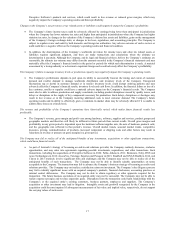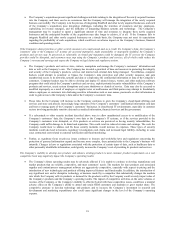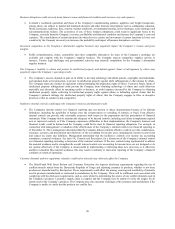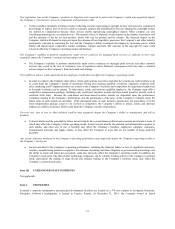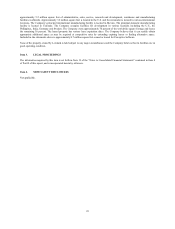Lexmark 2014 Annual Report Download - page 18
Download and view the complete annual report
Please find page 18 of the 2014 Lexmark annual report below. You can navigate through the pages in the report by either clicking on the pages listed below, or by using the keyword search tool below to find specific information within the annual report.President of the Company’s former Printing Solutions and Services Division (“PSSD”). Prior to such time, Mr. Rooke served as Vice
President and President of PSSD and Vice President and President of the Company’s former Business Printer Division.
Mr. Reeder has been Vice President and Chief Financial Officer of the Company since January 2015 when he joined the Company.
Prior to joining the Company, Mr. Reeder served as Chief Financial Officer of Electronics for Imaging, Inc. from January 2014 to
January 2015. From July 2012 to January 2014, Mr. Reeder served as Vice President, Finance of Cisco Systems, Inc.’s Enterprise
Networking Division. Prior to such time, Mr. Reeder served as Vice President and Managing Director, Asian Operations as well as
Senior Director, Controller, for Broadcom Corporation from October 2008 to June 2012.
Mr. Canning has been Executive Vice President and President of ISS since November 2010. From July 2010 to November 2010,
Mr. Canning served as Executive Vice President and President of PSSD and from July 2007 to July 2010 as Vice President and
President of PSSD. From January 2006 to July 2007, Mr. Canning served as Vice President and General Manager, PSSD Worldwide
Marketing and Lexmark Services and PSSD North American Sales and Marketing. From August 2002 to January 2006, Mr. Canning
served as Vice President and General Manager, PSSD Worldwide Marketing and Lexmark Services.
Mr. Coons has been Vice President of the Company and President and Chief Executive Officer of Perceptive Software since June
2010 when the Company acquired Perceptive Software. Prior to the acquisition, Mr. Coons served as President and Chief Executive
Officer of Perceptive Software from August 1995 to June 2010.
Mr. Foresti has been Vice President of Asia Pacific and Latin America since January 2008. From May 2003 to January 2008,
Mr. Foresti served as the Company’s Vice President and General Manager of Latin America.
Ms. Isbell has been Vice President of Human Resources of the Company since February 2003. From January 2001 to February 2003,
Ms. Isbell served as Vice President of Worldwide Compensation and Resource Programs in the Company’s Human Resources
department.
Mr. Patton has been Vice President, General Counsel and Secretary of the Company since October 2008. From June 2008 to October
2008, Mr. Patton served as Acting General Counsel and Secretary. From February 2001 to June 2008, Mr. Patton served as Corporate
Counsel.
Mr. Stromquist has been Vice President, ISS and Corporate Finance since November 2010, except from May 2014 to January 2015,
when Mr. Stromquist served as Vice President and Interim Chief Financial Officer. From June 2009 to November 2010,
Mr. Stromquist served as Vice President, PSSD and Corporate Finance. From July 2001 to June 2009, Mr. Stromquist served as Vice
President and Corporate Controller of the Company.
Intellectual Property
The Company’s intellectual property is one of its major assets and the ownership of the technology used in its products is important to
its competitive position. Lexmark seeks to establish and maintain the proprietary rights in its technology and products through the use
of patents, copyrights, trademarks, trade secret laws, and confidentiality agreements.
Lexmark holds a portfolio of approximately 1,439 U.S. patents and approximately 462 pending U.S. patent applications. The
Company also holds approximately 757 foreign patents and pending patent applications. These patents generally have a term of
twenty years from the time they are filed. As the Company’s patent portfolio has been developed over time, the remaining terms on
the individual patents vary. The inventions claimed in these patents and patent applications cover aspects of the Company’s current
and potential future products, manufacturing processes, business methods and related technologies. The Company is developing a
portfolio of patents that protects its product lines and offers the possibility of entering into licensing agreements with others. While the
Company believes that its portfolio of patents and applications have value, no single patent is in itself essential to our business as a
whole or any individual segment.
Lexmark has a variety of intellectual property licensing and cross-licensing agreements with a number of third parties. Certain of
Lexmark’s material license agreements, including those that permit the Company to manufacture some of its current products,
terminate as to specific products upon certain “changes of control” of the Company.
The Company has trademark registrations or pending trademark applications for the name LEXMARK in approximately 90 countries
for various categories of goods and services. Lexmark also owns a number of trademark applications and registrations for various
product names. The Company holds worldwide copyrights in computer code and publications of various types. Other proprietary
information is protected through formal procedures, which include confidentiality agreements with employees and other entities.
Lexmark’s success depends in part on its ability to obtain patents, copyrights and trademarks, maintain trade secret protection and
operate without infringing the proprietary rights of others. While Lexmark designs its products to avoid infringing the intellectual
property rights of others, current or future claims of intellectual property infringement, and the expenses resulting there from, could
14


